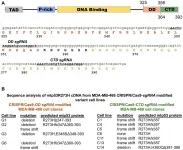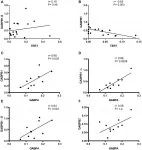(Press-News.org) NEW YORK, NY (July 26, 2021)--Two types of drugs that are recommended as a first treatment for patients with high blood pressure were found equally effective in improving cardiovascular outcomes, but the more popular type causes slightly more side effects, finds a multinational observational study led by researchers at Columbia University Vagelos College of Physicians and Surgeons.
The study, which analyzed claims and electronic health data from millions of patients worldwide, is the largest to compare the safety and efficacy of angiotensin-converting enzyme (ACE) inhibitors and angiotensin receptor blockers (ARBs), two commonly prescribed antihypertensive drugs.
"Physicians in the United States and Europe overwhelmingly prescribe ACE inhibitors, simply because the drugs have been around longer and tend to be less expensive than ARBs," says George Hripcsak, MD, the Vivian Beaumont Allen Professor and chair of biomedical informatics at Columbia University Vagelos College of Physicians and Surgeons and senior author of the study.
"But our study shows that ARBs are associated with fewer side effects than ACE inhibitors. The study focused on first-time users of these drugs. If you're just starting drug therapy for hypertension, you might consider trying an ARB first. If you're already taking an ACE inhibitor and you're not having any side effects, there is nothing that we found that would indicate a need for a change."
The study was published online in Hypertension.
Narrowing Down Choices
Once a physician decides to prescribe medication to control a patient's high blood pressure, the next decision--which one to choose--is complicated.
"U.S. and European hypertension guidelines list 30 medications from five different drug classes as possible choices, yet there are very few head-to-head studies to help physicians determine which ones are better," Hripcsak says. "In our research, we are trying to fill in this information gap with real-world observational data."
ACE inhibitors and ARBs are among the choices, and they have a similar mechanism of action. Both reduce the risk of stroke and heart attacks, though it's known that ACE inhibitors are associated with increased risk of cough and angioedema (severe swelling in the face and airways).
"We wanted to see if there were any surprises--were both drug classes equally effective, and were ARBs producing any unexpected side effects when used in the real world?" Hripcsak says. "We're unlikely to see head-to-head clinical trials comparing the two since we are reasonably sure that both are effective."
Electronic Health Records Provide Answer
The researchers instead turned to large databases to answer their questions. They analyzed insurance claims and electronic health records from approximately 3 million patients in Europe, Korea, and the United States who were starting antihypertensive treatment with either an ACE inhibitor or an ARB.
Data from electronic health records and insurance claims are challenging to use in research. They can be inaccurate, incomplete, and contain information that biases the results. So the researchers employed a variety of cutting-edge mathematical techniques developed by the Observational Health Data Science and Informatics (OHDSI) collaborative network to dramatically reduce bias and balance the two treatment groups as if they had been enrolled in a prospective study.
Using this approach, the researchers tracked four cardiovascular outcomes--heart attack, heart failure, stroke, and sudden cardiac death--and 51 adverse events in patients after they started antihypertensive treatment.
The researchers found that the vast majority of patients--2.3 million--were prescribed an ACE inhibitor. There were no significant differences between the two drug classes in reducing the risk of major cardiovascular complications in people with hypertension. Patients taking ACE inhibitors had a higher risk of cough and angioedema, but the study also found they had a slightly higher risk of pancreatitis and gastrointestinal bleeding.
"Our study largely confirmed that both antihypertensive drug classes are similarly effective, though ARBs may be a little safer than ACE inhibitors," Hripcsak says. "This provides that extra bit of evidence that may make physicians feel more comfortable about prescribing ARBs versus ACE inhibitors when initiating monotherapy for patients with hypertension. And it shows that large-scale observational studies such as this can offer important insight in choosing among different treatment options in the absence of large randomized clinical trials."
INFORMATION:
More Information
The study, titled "Comparative first-line effectiveness and safety of angiotensin converting enzyme inhibitors and angiotensin receptor blockers: a multinational cohort study," was published online July 26, 2021, in Hypertension.
Additional authors are RuiJun Chen (Geisinger Health), Marc Suchard (University of California Los Angeles), Harlan Krumholz (Yale University), Martijn Schuemie (Janssen Research and Development), Steven Shea (Columbia), Jon Duke (Georgia Tech College of Computing), Nicole Pratt (University of South Australia), Christian Reich (OHDSI), David Madigan (Northeastern University), Seng Chan You (Ajou University School of Medicine), and Patrick Ryan (Janssen).
The study was funded by the National Institutes of Health, National Science Foundation, and the Ministries of Health & Welfare and of Trade, Industry & Energy, Republic of Korea.
The Columbia authors report no financial or other conflicts of interest.
Columbia University Irving Medical Center provides international leadership in basic, preclinical, and clinical research; medical and health sciences education; and patient care. The medical center trains future leaders and includes the dedicated work of many physicians, scientists, public health professionals, dentists, and nurses at the Vagelos College of Physicians and Surgeons, the Mailman School of Public Health, the College of Dental Medicine, the School of Nursing, the biomedical departments of the Graduate School of Arts and Sciences, and allied research centers and institutions. Columbia University Irving Medical Center is home to the largest medical research enterprise in New York City and State and one of the largest faculty medical practices in the Northeast. For more information, visit cuimc.columbia.edu or columbiadoctors.org.
Citrus fruits from the mandarin family have important commercial value but how their diversity arose has been something of a mystery
Researchers analyzed the genomes of the East Asian varieties and found a second center of diversity in the Ryukyu Islands along with the previously known center in the mountains of southern China
They discovered a new citrus species native to Okinawa that arose about two million years ago when the Ryukyu archipelago became disconnected from mainland Asia
Other citrus from Okinawa and mainland Japan, including shiikuwasha and tachibana, are hybrids of this newly discovered wild species with different mainland Asian varieties
This research may have commercial implications and ...
Canada should anticipate a resurgence of a childhood respiratory virus as COVID-19 physical distancing measures are relaxed, authors warn in CMAJ (Canadian Medical Association Journal).
Cases of respiratory syncytial virus (RSV) have risen sharply in Australia and, more recently, the United States as COVID-19 case counts have waned and pandemic public health measures have been relaxed. Respiratory syncytial virus affects the lower respiratory tract and can cause serious illness and death. Before the COVID-19 pandemic, about 2.7 million children worldwide were infected with RSV each year, and it was the fourth most common cause of death in young children.
"The off-season resurgence in seasonal respiratory viruses now potentially poses a threat to vulnerable infants," ...
A new "return to campus" survey led by The Ohio State University's Office of the Chief Wellness Officer finds rising rates of anxiety, depression, burnout and the use of unhealthy coping mechanisms among students navigating through a year affected by the COVID-19 pandemic, similar to other data on college students throughout the U.S.
Ohio State conducted surveys in August 2020 and April 2021 of randomly-selected students to assess changes in mental health, coping strategies, healthy lifestyle behaviors and needs over time. Among the 1,072 Ohio State students who responded:
Students who screened positive for anxiety:
August 2020: 39%
April 2021: 42.6%
Students who screened positive for depression:
August 2020: 24.1%
April 2021: 28.3%
Students who screened ...
PITTSBURGH, July 26, 2021 - Adolescents who set goals for their future and those with strong parental support are less likely to use e-cigarettes and other tobacco products, according to a study by UPMC Children's Hospital of Pittsburgh and University of Pittsburgh School of Medicine physician-scientists.
The research, published today in the journal Pediatrics, suggests that strategies to prevent youth vaping may be different from what works to dissuade youth from smoking cigarettes.
"The use of e-cigarettes by young people is at epidemic proportions, with 27% of youth ...
Survival rates for adolescents and young adults diagnosed with cancer have varied considerably depending on cancer type. A new study indicates that survival for multiple cancer types in such patients has improved in recent years, but some patients diagnosed with common cancer types still show limited survival improvements. The results are published by Wiley early online in CANCER, a peer-reviewed journal of the American Cancer Society.
For the study, investigators at the National Cancer Institute analyzed survival trends related to cancers with the highest mortality rates in adolescents and young adults. Relying on information from the Surveillance, Epidemiology, and End Results (SEER) cancer ...
Oncotarget published "Frame-shift mediated reduction of gain-of-function p53 R273H and deletion of the R273H C-terminus in breast cancer cells result in replication-stress sensitivity" which reported that these authors recently documented that gain-of-function mutant p53 R273H in triple negative breast cancer cells interacts with replicating DNA and PARP1. The missense R273H GOF mtp53 has a mutated central DNA binding domain that renders it unable to bind specifically to DNA, but maintains the capacity to interact tightly with chromatin.
Both the C-terminal domain ...
Oncotarget published "TERT and its binding protein: overexpression of GABPA/B in high grade gliomas" which reported that all GA-binding proteins progress through the glioma grades and have the highest expression levels in secondary glioblastomas.
In secondary glioblastomas after chemotherapy, GABPB1 and GABPB1-L are expressed on a lower level than without treatment.
Between primary and secondary glioblastomas with and without chemotherapy, TERT is elevated in the former while GABPB1 is increased in the secondary glioblastomas.
GABPA and GABPB1, GABPB1-L and GABPB1-S positively correlate in primary glioblastomas.
This ...
Thermal-imaging sensors that detect and capture images of the heat signatures of human bodies and other objects have recently sprung into use in thermostats to check facial temperatures in a contactless attempt to screen for COVID-19 at several building entrances. Under these circumstances, the smartphone industry is actively considering the incorporation of such sensors as portable features to create the add-on function of measuring temperature in real time. Additionally, the application of such technology to autonomous vehicles may facilitate safer autonomous driving.
A research team lead by Dr. ...
The feeling of a needle piercing skin is familiar to most people, especially recently as COVID-19 vaccinations gain momentum. But what exactly happens when a needle punctures skin? The answer is revealed in a new paper published recently in the Journal of the Mechanics and Physics of Solids. ...
Even in the absence of bark beetle outbreaks and wildfire, trees in Colorado subalpine forests are dying at increasing rates from warmer and drier summer conditions, found recent University of Colorado Boulder research.
The study, published in the May print issue of the Journal of Ecology, also found that this trend is increasing. In fact, tree mortality in subalpine Colorado forests not affected by fire or bark beetle outbreaks in the last decade has more than tripled since the 1980s.
"We have bark beetle outbreaks and wildfires that cause very obvious mortality of trees in Colorado. But we're showing that even in the areas that people go hiking in and where the forest looks healthy, mortality is increasing ...





